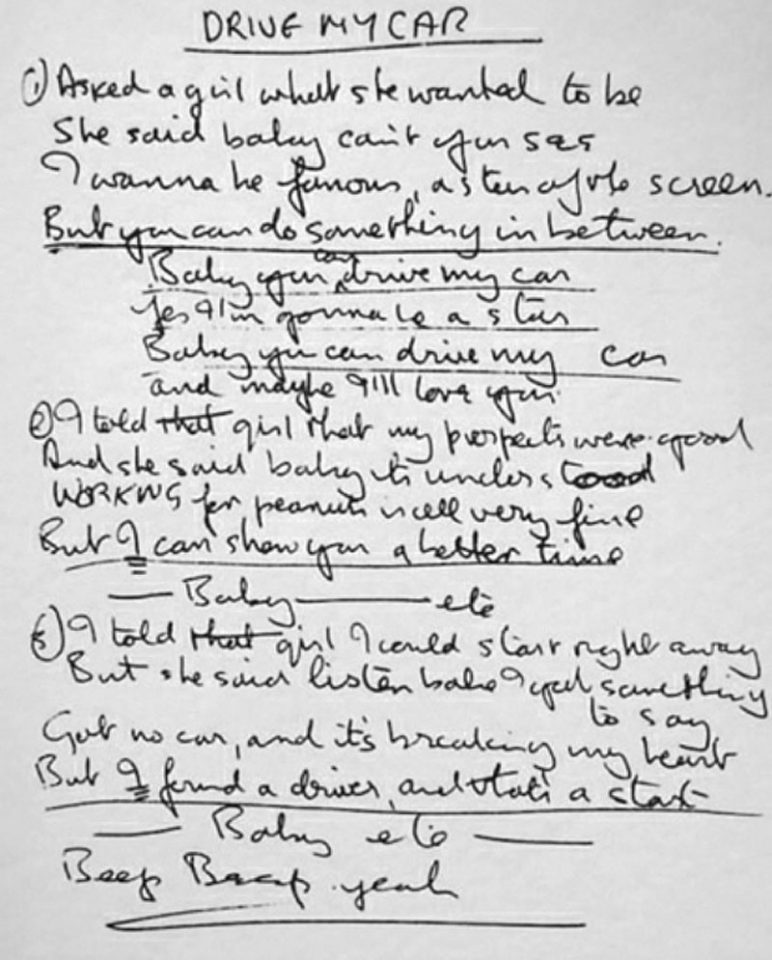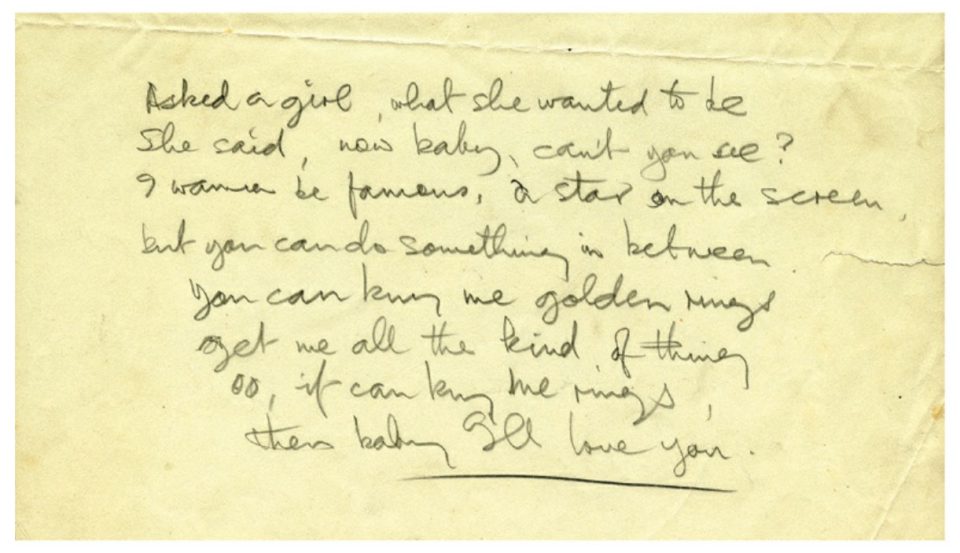Written by: Lennon-McCartney
Recorded: 13 October 1965
Producer: George Martin
Engineer: Norman Smith
Released: 3 December 1965 (UK), 15 June 1966 (US)
Available on:
Rubber Soul
Love
Personnel
- Paul McCartney: vocals, lead guitar, rhythm guitar, bass
- John Lennon: vocals, piano, tambourine
- George Harrison: harmony vocals, guitar
- Ringo Starr: drums, cowbell
About The Song
The initial track on the 1965 album “Rubber Soul,” titled ‘Drive My Car,’ challenged the conventional gender roles depicted in The Beatles’ songs. It narrates the story of an aspiring female star and gold digger seeking a man to serve as both a chauffeur and for intimate favors.
In the initial version crafted by Paul McCartney, the chorus centered on the phrase, “You can buy me golden rings.” McCartney and John Lennon faced challenges while reworking the song but eventually moved away from clichés, opting for a narrative centered around a strong-willed woman.
The lyrics were disastrous and I knew it… This is one of the songs where John and I came nearest to having a dry session. The lyrics I brought in were something to do with golden rings, which is always fatal. ‘Rings’ is fatal anyway, ‘rings’ always rhymes with ‘things’ and I knew it was a bad idea. I came in and I said, ‘These aren’t good lyrics but it’s a good tune.’ The tune was nice, the tune was there, I’d done the melody. Well, we tried, and John couldn’t think of anything, and we tried and eventually it was, ‘Oh let’s leave it, let’s get off this one.’ ‘No, no. We can do it, we can do it.’ So we had a break, maybe had a cigarette or a cup of tea, then we came back to it, and somehow it became ‘drive my car’ instead of ‘gold-en rings’, and then it was wonderful because this nice tongue-in-cheek idea came and suddenly there was a girl there, the heroine of the story, and the story developed and had a little sting in the tail like ‘Norwegian Wood’ had, which was ‘I actually haven’t got a car, but when I get one you’ll be a terrific chauffeur.’

The song contained clear sexual overtones, from the first verse’s “You can do something in between” to the suggestive promises of “a better time”.
’Drive my car’ was an old blues euphemism for sex, so in the end all is revealed. Black humour crept in and saved the day. It wrote itself then. I find that very often, once you get the good idea, things write themselves.
Many Years From Now
The arrangement was suggested by George Harrison, who had been listening to Otis Redding’s ‘Respect’, then a minor hit. Harrison suggested that the bass and guitar parts should play similar lines in an approximation of Redding’s bass-heavy sound, resulting in one of The Beatles’ most effective performances of 1965.
I helped out such a lot in all the arrangements. There were a lot of tracks though where I played bass. Paul played lead guitar on ‘Taxman’, and he played guitar – a good part – on ‘Drive My Car’.
We laid the track because what Paul would do, if he’s written a song, he’d learn all the parts for Paul and then come in the studio and say, ‘Do this.’ He’d never give you the opportunity to come out with something. But on ‘Drive My Car’ I just played the line, which is really like a lick off ‘Respect’, you know, the Otis Redding version – and I played that line on guitar and Paul laid that with me on bass. We laid the track down like that. We played the lead part later on top of it.
Crawdaddy
The 2006 album Love mixed ‘Drive My Car’ with extracts from ‘The Word’ and ‘What You’re Doing’, together with guitar solo from ‘Taxman’ and horns from ‘Savoy Truffle’.

During the studio session on October 13, 1965, ‘Drive My Car’ was recorded. The recording session, commencing at 7 pm and concluding at 12:15 am, marked The Beatles’ first session to extend beyond midnight.
Perfecting the arrangement for ‘Drive My Car’ took some time. Although four takes of the rhythm track were recorded, only the final one was comprehensive.
The foundational arrangement featured Paul McCartney on bass guitar, George Harrison playing guitar (contrary to his Anthology recollections), John Lennon on tambourine, and Ringo Starr on drums. The group later added overdubs, including piano, lead guitar, piano, and cowbell parts. Additionally, lead vocals were contributed by Lennon and McCartney, with backing vocals by Harrison.
